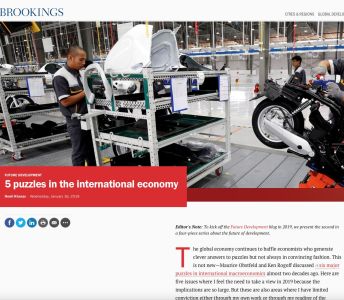
Homi Kharas
5 Puzzles in the International Economy
Brookings Institution, 2019
What's inside?
Several aspects of the world economy are confounding.
Recommendation
Researcher Homi Kharas provides a thought-provoking look at five current and perplexing macroeconomic conditions: low net capital flows to developing economies, sluggish growth in global productivity, unresolvable externalities, elusive agreement about progress, and underinvestment in nutrition and education. In this brief but elucidating article, Kharas offers no new solutions, but he poses these conundrums in a way that will help readers better understand the challenges they present.
Take-Aways
- In 2019, the complex world economy presents critical challenges in five areas.
- First, not enough capital flows for investment are going to emerging markets. Second, global productivity growth is weak.
- Third, countries are not resolving labor and environmental externalities.
- Fourth, determining whether progress in improving living standards contributes to society’s overall welfare remains difficult.
- Fifth, resources for nutrition and education are underallocated, compared to their economic returns.
Summary
The world’s economy is interconnected in complex tangles that raise consequential challenges. Five are especially critical due to the breadth of their impacts:
- “Why is so little capital flowing to emerging and developing countries?” – In 2019, net amounts moving into these economies will total about $4 billion, a paltry sum compared to their $35 trillion aggregate size and woefully inadequate to fund growth-generating infrastructure such as roads, ports, electricity and education.
- “What is going on with global productivity growth?” – Experts associate rising productivity with better living standards, so lackluster increases are troubling. They might be the result of inadequate levels of innovation or of lags between invention and adoption. Perhaps growth is taking place, but current metrics aren’t capturing it. Drags on productivity in the advanced economies could suppress growth in emerging markets.
- “Why is it so hard to fix externalities?” – Today, countries pursue policies “that tax labor and subsidize fossil fuels.” The 2017 average “tax wedge on labor” in OECD countries was 35.9%, despite a global need for more jobs. Governments in the G-7 want to eliminate greenhouse gas emissions by 2025. But they support carbon-producing energy industries to the tune of $100 billion annually.
- “What constitutes progress in the world?” – China and the United States, “perhaps the most consequential relationship in the world,” highlight a macroeconomic dilemma. China offers either an enormous boon to the US economy or a geopolitical threat, depending on your point of view. Another quandary concerns the unequal distribution of gains in living standards. While some benefit from economic progress, others don’t, and so measures of “life satisfaction” in fast-growing economies like those of India and China are on the decline.
- “Why don’t we spend much more on nutrition and education?” – The return on investment in children’s nourishment is more than 40 times, in terms of productivity, over their adult lives. Similar yields also occur for treatments to prevent tuberculosis, HIV/AIDS and malaria, which are receiving greater funding. Yet global nutrition and education aid continue to significantly lag what’s needed to achieve the UN’s Sustainable Development Goals.
About the Author
Homi Kharas is interim vice president and director of the Global Economy and Development Program at the Brookings Institution.
This document is restricted to personal use only.
My Highlights
Did you like this summary?
Read the articleThis summary has been shared with you by getAbstract.
We find, rate and summarize relevant knowledge to help people make better decisions in business and in their private lives.
Already a customer? Log in here.



















Comment on this summary